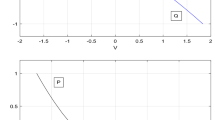Abstract
In this paper we present a model from which discretionary consumption dynamics can be analyzed as global properties emerging from the endogenous transformation of a society inhabited by boundedly rational interactive consumers. By considering local and global interactions among consumers, we show that behavioral diversity plays a central role in the evolution of consumption patterns. The analysis of the model reveals the existence of a regime characterized by the persistence of different social standards, and a time evolution of the social distribution of behavioral patterns towards a heteroclinic cycle. In some cases the evolution seems to be chaotic, generating unpredictable, erratic dynamics of the aggregate social indices (average or social propensity for discretionary consumption).
Similar content being viewed by others
References
Aguiar, M., Castro, S., & Laboriau, I. (2004). Dynamics near a heteroclinic network. Preprint, Centro de Matemática da Universidade do Porto.
Aversi R., Dosi G., Fagiolo G., Meacci M., Olivetti C. (1999) Demand dynamics with socially evolving preferences. Industrial and Corporate Change 8: 353–399
Baudrillard, J. (1981). For a critique of the political economy of the signs. St. Louis: Telos Press.
Becker G.S. (1996) Accounting for tastes. Harvard University Press, Cambridge
Bernheim B.D. (1994) A theory of conformity. Journal of Political Economy 102(5): 841–877
Bourdieu P. (1979) La Distinction. Minuit, Paris
Brannath W. (1994) Heteroclinic networks on the tetrahedron. Nonlinearity 7: 1367–1384
Chawanya T. (1995) A new type of irregular motion in a class of game dynamics systems. Progress of Theoretical Physics 94: 163–179
Corneo G., Jeanne O. (1999) Segmented communication and fashionable behavior. Journal of Economic Behavior & Organization 39: 371–385
Cowan R., Cowan W., Swann P. (1997) A model of demand with interactions among consumers. International Journal of Industrial Organization 15: 711–732
Deaton A. (1992) Understanding consumption. Oxford University Press, Oxford
Earl P.E. (1986) Lifestyle economics: Consumer behavior in a turbulent world. Brighton, Wheatsheaf
Earl P.E. (1998) Consumer goals as journeys into the unknown. In: M. Bianchi (eds) The active consumer. Routledge, London
Granovetter M., Soong R. (1986) Threshold models of interpersonal effects in consumer demand. Journal of Economic Behavior and Organization 7: 83–99
Gualerzi D. (2001) Consumption and growth: Recovery and structural change in the US Economy. Cheltenham, Edward Elgar
Guckenheimer J., Worfolk P. (1992) Instant chaos. Nonlinearity 5: 1211–1222
Hodgson G. (2000) The hidden persuaders. Institutions and choice in economic theory. University of Hertfordshire, Inaugural Lecture
Hofbauer J., Sigmund K. (1998) Evolutionary games and population dynamics. Cambridge University Press, Cambridge
Lancaster K.J. (1966) A new approach to consumer theory. Journal of Political Economy 4: 132–157
Langlois, R. N. (2001). Knowledge, consumption and endogenous growth. Journal of Evolutionary Economics, 11.
Leiss, W. (1983). The icons of the market place. Theory, Culture and Society, 1(3).
Loasby B. (2001) Cognition, imagination and institutions in demand creation. Journal of Evolutionary Economics 11: 7–21
Melbourne I. (1991) An example of a non-asymptotically stable attractor. Nonlinearity 4: 835–844
Metcalfe S. (2001) Consumption, preferences and the evolutionary agenda. Journal of Evolutionary Economics 11: 37–58
Schor J. (1999) The overspent American. Harper Perennial, New York
Scitovsky T. (1976) The joyless economy. An inquiry into human satisfaction and consumer dissatisfaction. Oxford University Press, Oxford
Simon H.A. (1983) Reason in human affairs. Stanford University Press, Stanford
Sobel E. (1982) Lifestyle. Academic Press, New York
Stigler G.J., Becker G.S. (1977) De gustibus non est disputandum. American Economic Review 67: 76–90
Turab R., Abu S., Sethi R. (1998) Novelty, imitation and habit formation in a Scitovskian model of consumption. In: Bianchi M. (eds) The active consumer. Routledge, London
Veblen T. (1899) The theory of the leisure class. Macmillan, London
Witt, U. (eds) (2001) Escaping satiation. The demand side of economic growth. Springer-Verlag, Berlin
Author information
Authors and Affiliations
Corresponding author
Rights and permissions
About this article
Cite this article
Fatás-Villafranca, F., Saura, D. & Vazquez, F.J. Diversity, persistence and chaos in consumption patterns. J Bioecon 11, 43–63 (2009). https://doi.org/10.1007/s10818-009-9059-8
Published:
Issue Date:
DOI: https://doi.org/10.1007/s10818-009-9059-8




